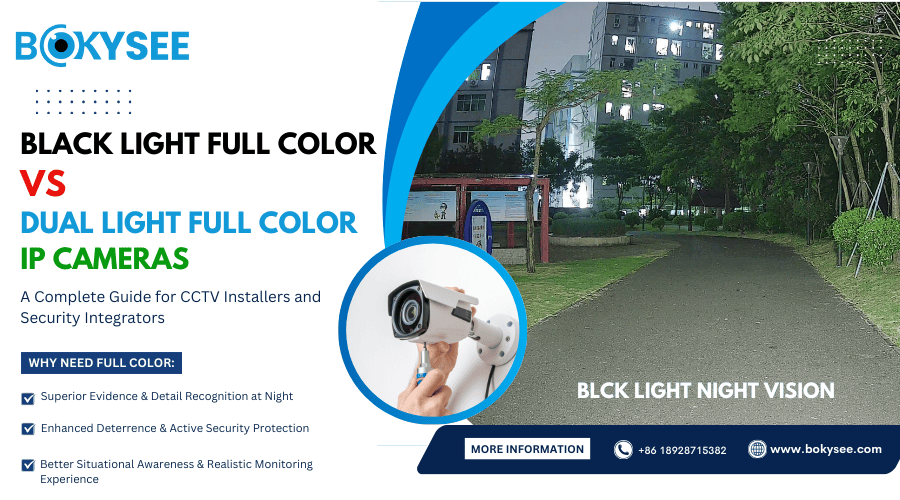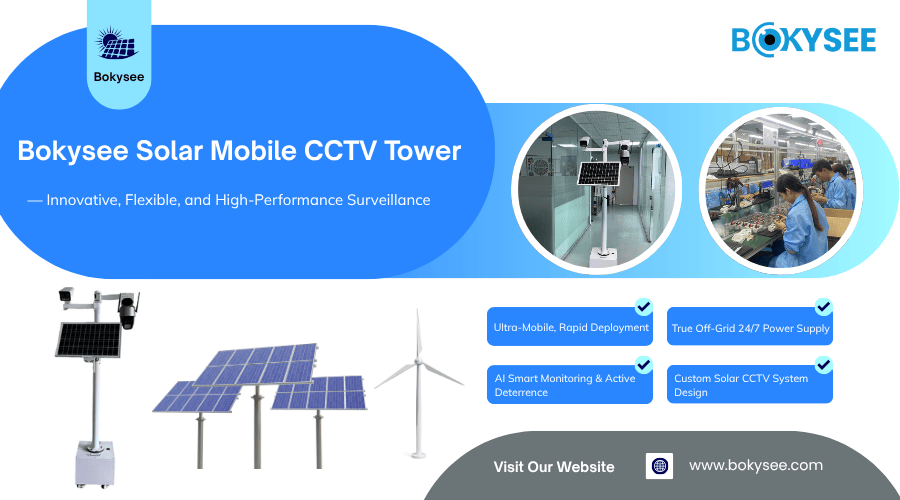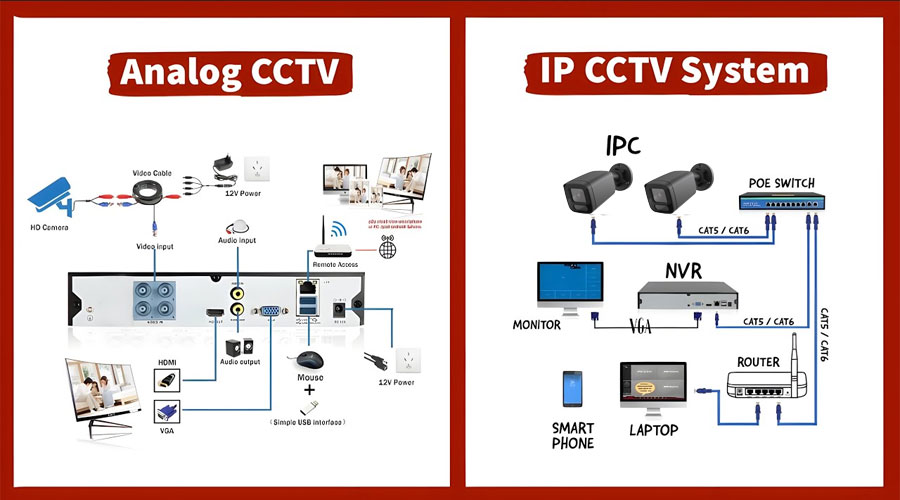
Diferencias clave entre los tipos de cámaras
Explore las características esenciales de las cámaras analógicas e IP.
|
Características |
Cámaras de seguridad IP |
cámaras de seguridad analógicas |
|---|---|---|
|
Calidad de vídeo |
Mayor resolución, imágenes más claras. |
Menor resolución, menos detalles. |
|
Proceso de instalación |
Más fácil y con menos cables necesarios. |
Requiere varios cables para la configuración. |
|
Costo |
Se requiere una mayor inversión inicial. |
Costos iniciales más asequibles. |
|
Características |
Incluye funciones avanzadas como acceso remoto. |
Funciones limitadas, funcionalidad básica. |
|
Escalabilidad |
Fácilmente ampliable con integración de red. |
Difícil de ampliar debido al cableado. |
|
Opciones de almacenamiento |
Admite almacenamiento local y en la nube. |
Utiliza DVR con almacenamiento limitado. |
|
Calidad de la señal |
Las señales digitales mantienen la calidad a lo largo de la distancia. |
La calidad de la señal se degrada a largas distancias. |
|
Mantenimiento |
Requiere actualizaciones periódicas y comprobaciones de red. |
Mantenimiento más sencillo, menos actualizaciones necesarias. |
Las cámaras de seguridad son importantes para mantener hogares y lugares seguros. Existen dos tipos principales: cámaras analógicas e IP. Las cámaras analógicas son más económicas y fáciles de usar. Las cámaras IP tienen mejores características e imágenes más nítidas. Conocer estas diferencias te ayudará a elegir la mejor opción para tus necesidades.
Comprender los conceptos básicos de las cámaras de seguridad
¿Qué son las cámaras de seguridad analógicas?
Definición y descripción general
Las cámaras analógicas son un tipo de cámara más antiguo. cámara de seguridadGraban video en formato analógico y lo envían por cables a dispositivos como DVR. Estos sistemas se han utilizado durante años por su simplicidad y fiabilidad.
Cómo funcionan
Las cámaras analógicas utilizan señales eléctricas para enviar video. La cámara toma imágenes y las envía como señales a través de cables a un DVR. El DVR guarda el video para su posterior visualización. Cada cámara necesita su propio cable para conectarse al DVR, lo que puede requerir mucho cableado.
Características principales de las cámaras de seguridad analógicas
-
Asequible:Las cámaras analógicas cuestan menos y son buenas para un uso básico.
-
Fácil de usar:Su diseño sencillo hace que sean fáciles de instalar y reparar.
-
Funciona con DVR:La mayoría de las cámaras analógicas se conectan fácilmente a los sistemas DVR.
-
Vídeo de menor calidadLa resolución de video generalmente es de 480p a 720p, por lo que es posible que pequeños detalles como rostros o matrículas no se vean claros.
-
Problemas de señal:Las señales pueden debilitarse en largas distancias o sufrir interferencias.
¿Qué son las cámaras de seguridad IP?
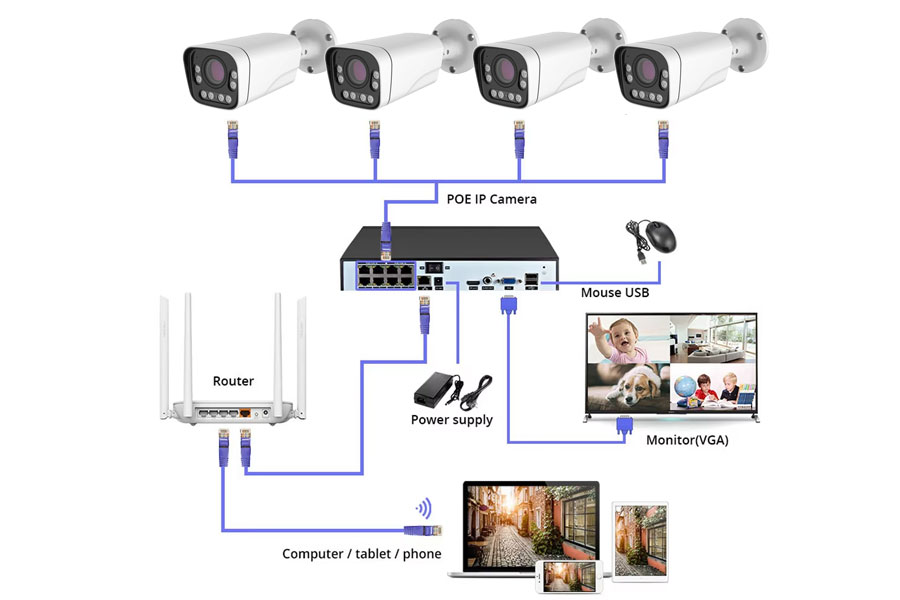
Definición y descripción general
Las cámaras IP, o cámaras de protocolo de Internet, utilizan tecnología digital para grabar y enviar video. Ofrecen imágenes más claras y tienen más funciones que las cámaras analógicas, cumpliendo con las necesidades modernas. seguridad necesidades.
Cómo funcionan
Las cámaras IP convierten el video en datos digitales dentro de la cámara. Envían estos datos mediante cables Ethernet o de forma inalámbrica a un NVR o almacenamiento en la nube. Esta configuración elimina la necesidad de cables de alimentación y video separados, lo que facilita la instalación.
Características principales de las cámaras de seguridad IP
-
Vídeo claro:Las cámaras IP tienen resoluciones de 1,3 a 5 megapíxeles para imágenes nítidas.
-
Características adicionales:Muchos tienen detección de movimiento, visualización remota y herramientas de video inteligente.
-
Expandible: Puede añadir más cámaras al sistema fácilmente.
-
Opciones inalámbricas:Algunas cámaras IP funcionan de forma inalámbrica, lo que reduce la necesidad de cables.
-
Mejor calidad de imagen:Las señales digitales proporcionan imágenes más claras con menos ruido que las analógicas.
Aprender estos conceptos básicos le ayudará a: comparar cámaras analógicas e IPCada tipo tiene beneficios especiales para diferentes seguridad necesidades.
Comparación de cámaras de seguridad analógicas e IP
Calidad de vídeo
Diferencias de resolución entre cámaras analógicas e IP
Las cámaras analógicas suelen mostrar videos con una resolución de 480p a 720p. Esto puede hacer que las imágenes se vean borrosas, especialmente en detalles pequeños como los rostros. Las cámaras IP ofrecen videos más nítidos con resoluciones de 1,3 a 5 megapíxelesLa mayor resolución hace que las cámaras IP sean mejores para una vigilancia detallada.
Claridad en diversas condiciones de iluminación
Las cámaras analógicas no funcionan bien con poca o mucha luz. Las sombras o el resplandor pueden dificultar la visión clara de los objetos. Las cámaras IP se adaptan mejor a estas condiciones. funciones avanzadasHerramientas como el amplio rango dinámico (WDR) y los infrarrojos ayudan a mostrar imágenes claras en condiciones de iluminación difíciles.
Instalación y configuración
Proceso de instalación de cámaras analógicas
Las cámaras analógicas necesitan cables separados para video y alimentación. Cada cámara se conecta a un DVR, lo que puede requerir mucho cableado. El DVR también debe estar cerca de las cámaras para evitar señales débiles. Esta configuración puede requerir más tiempo y esfuerzo.
Proceso de instalación de cámaras IP
Las cámaras IP utilizan un solo cable Ethernet para la alimentación y los datos. Algunas cámaras IP son inalámbricas, por lo que no necesitan cables. Se conectan directamente a una red, sin necesidad de un DVR. Esto facilita y agiliza la instalación.
Consideraciones de costos
Costos iniciales de cámaras analógicas vs. cámaras IP
Las cámaras analógicas cuestan menos al principio, a partir de aproximadamente $40Esto las convierte en una buena opción para personas con un presupuesto limitado. Las cámaras IP cuestan más, a partir de $100 o superiorSu precio incluye características como acceso remoto y mejor calidad de video.
Costos y mantenimiento a largo plazo
Los sistemas analógicos pueden resultar más costosos con el tiempo debido a las reparaciones y actualizaciones. Sus cables y tecnología antigua pueden requerir reparaciones frecuentes. Las cámaras IP son más caras al principio, pero luego ahorran dinero. Son más fáciles de actualizar y mantener, lo que las convierte en una mejor opción a largo plazo.
Conectividad y almacenamiento
Opciones de almacenamiento analógico (por ejemplo, DVR)
Las cámaras analógicas usan DVR para guardar las grabaciones de video. Cada cámara se conecta al DVR mediante cables coaxiales. El video se almacena en formato analógico, lo que reduce la calidad. Los DVR tienen espacio limitado y necesitan actualizaciones cuando se llenan. Para conservar los videos antiguos, los usuarios deben transferir los archivos a unidades externas. Este proceso requiere tiempo y esfuerzo adicionales.
Los sistemas analógicos pueden presentar problemas de señal durante la transferencia de datos. Estos problemas pueden empeorar la calidad del video. Los cables físicos también limitan la ubicación de las cámaras. Para un almacenamiento simple y económico, los DVR funcionan bien, pero carecen de flexibilidad.
Opciones de almacenamiento local y en la nube para cámaras IP
Las cámaras IP ofrecen almacenamiento en la nube y local Opciones. El almacenamiento en la nube guarda videos en línea, para que los usuarios puedan acceder a ellos desde cualquier lugar con internet. Esto elimina la necesidad de actualizaciones de hardware. Muchos planes en la nube permiten a los usuarios agregar más almacenamiento según sea necesario.
El almacenamiento local utiliza NVR para guardar video digital de alta calidad. Los NVR se conectan a las cámaras a través de una red, por lo que requieren menos cableado que los DVR. Algunas cámaras IP también utilizan tarjetas SD para almacenar el video directamente en la cámara.
Los sistemas IP mantienen la seguridad de los datos mediante cifrado para bloquear el acceso no autorizado. Estas opciones avanzadas de almacenamiento hacen que las cámaras IP sean ideales para usuarios que buscan opciones flexibles y seguras.
Escalabilidad y flexibilidad
Ampliación de un sistema de cámaras de seguridad analógicas
Añadir cámaras a un sistema analógico es más difícil debido a los cables. Cada cámara nueva necesita su propio cable coaxial para conectarse al DVR. Si se añaden más cámaras, se necesita un DVR más grande con más canales. Esto aumenta los costos y dificulta la instalación.
Los sistemas analógicos no permiten mucha flexibilidad en la ubicación de las cámaras. Los cables largos pueden debilitar las señales, lo que reduce la calidad del video. Para usuarios que necesitan más cámaras, los sistemas analógicos podrían no ser adecuados para configuraciones grandes.
Ampliación de un sistema de cámaras de seguridad IP
Los sistemas IP son fácil de expandir Y muy flexible. Las nuevas cámaras pueden conectarse a la red mediante cables Ethernet o de forma inalámbrica. La mayoría de los NVR admiten varias cámaras, lo que facilita la incorporación de más.
Las cámaras IP inalámbricas se pueden instalar en lugares de difícil acceso sin necesidad de cables. Ofrecen funciones como la alimentación a través de Ethernet (PoE). combinar potencia y datos en un solo cable, ahorrando tiempo y dinero.
Los sistemas IP se adaptan fácilmente a las necesidades cambiantes. Pueden añadir funciones inteligentes y más cámaras, lo que los convierte en una excelente opción para uso a largo plazo.
Pros y contras de cada tipo
Ventajas de las cámaras de seguridad analógicas
Rentabilidad de los sistemas analógicos
Las cámaras analógicas son una opción más económica para necesidades de seguridad. Son más económicas que las cámaras IP, lo que las hace económicas. Las personas con presupuesto limitado pueden instalar un sistema básico. Los sistemas analógicos suelen usar cables existentes, lo que ahorra costos adicionales.
Simplicidad en el diseño y uso
Las cámaras analógicas son sencillas y fáciles de usar. Para configurarlas, solo hay que conectarlas a un DVR. Este proceso no requiere mucha experiencia técnica. Su mantenimiento es sencillo, ya que carecen de funciones complejas. Son ideales para usuarios que buscan un sistema básico.
Desventajas de las cámaras de seguridad analógicas
Funciones limitadas en comparación con las cámaras IP
Las cámaras analógicas no cuentan con las herramientas avanzadas de las cámaras IP. Carecen de funciones como la visualización remota o las alertas de movimiento. Quienes buscan herramientas de seguridad modernas pueden encontrarlas deficientes.
Menor calidad y resolución de video
Las cámaras analógicas tienen una calidad de video inferior, generalmente de 480p a 720p. Esto dificulta la visualización de pequeños detalles, como rostros. Las señales pueden debilitarse a largas distancias, lo que hace que los videos salgan borrosos. Para obtener imágenes nítidas, los sistemas analógicos no son la mejor opción.
Ventajas de las cámaras de seguridad IP
Calidad de imagen y vídeo de alta resolución
Las cámaras IP ofrecen videos muy claros y nítidos. Su resolución varía de 1,3 a 5 megapíxeles. Las señales digitales se mantienen nítidas incluso a largas distancias. Esto facilita la identificación de personas u objetos. Las cámaras IP son ideales para tareas de seguridad detalladas.
Funciones avanzadas (por ejemplo, acceso remoto, detección de movimiento)
Las cámaras IP cuentan con funciones modernas que las hacen muy útiles. Puedes ver videos en vivo en tu teléfono o computadora. Las alertas de movimiento te notifican rápidamente sobre actividades inusuales. Algunas cámaras incluso reconocen rostros o rastrean objetos. Estas características hacen de las cámaras IP una opción inteligente para las necesidades actuales.
Desventajas de las cámaras de seguridad IP
Mayores costos iniciales e inversión
Las cámaras IP son más caras al principio. Sus funciones avanzadas y la nitidez de su video las hacen caras. Una cámara IP suele costar $100 o más, mucho más que las analógicas. También hay que pagar por los NVR y los planes de almacenamiento en la nube. Estos costos adicionales pueden ser elevados para quienes tienen un presupuesto ajustado.
Configurar sistemas IP puede requerir herramientas especiales. Los cables Ethernet, los switches PoE o las mejores redes inalámbricas aumentan el precio. Quienes buscan seguridad de alta tecnología deben planificar estos gastos adicionales.
Complejidad en la configuración y el mantenimiento
Las cámaras IP son más difíciles de configurar que las analógicas. Es necesario conectarlas a una red y asignarles direcciones IP. Asegurarse de que funcionen con NVR requiere mucha atención. Para quienes no tienen muchos conocimientos de redes, esto puede resultar complicado.
El mantenimiento de los sistemas IP requiere tiempo. Es necesario actualizar el firmware, revisar el software y solucionar problemas de red. El vídeo de alta calidad consume mucho espacio de internet y almacenamiento. Gestionar estas necesidades requiere un esfuerzo constante.
Las cámaras IP necesitan una buena conexión a internet para funcionar correctamente. Una conexión débil puede impedir la transmisión de video o el acceso remoto. Las personas en zonas con mala conexión a internet pueden tener problemas con frecuencia. La complejidad de la configuración y el mantenimiento hace que los sistemas IP no sean ideales para quienes buscan soluciones sencillas.
Cómo elegir la cámara de seguridad adecuada a sus necesidades
Factores a tener en cuenta
Presupuesto y costos
El precio de las cámaras importa a la hora de elegir una. Las cámaras analógicas son más baratasIdeal para presupuestos ajustados. Las cámaras IP son más caras porque tienen mejores funciones. Con el tiempo, los precios varían. Los sistemas analógicos pueden necesitar más reparaciones. Las cámaras IP duran más y son más fáciles de actualizar.
Ubicación y tamaño del área
El tamaño del área influye en su elección. Las cámaras analógicas funcionan bien en espacios pequeños. Los lugares grandes, como los estacionamientos, necesitan cámaras IP para una visión clara. Las áreas exteriores necesitan cámaras resistentes a la intemperie, que suelen encontrarse en los modelos IP.
Conexiones cableadas o inalámbricas
Los sistemas cableados son estables, pero requieren muchos cables. Las cámaras analógicas usan cables coaxiales para la alimentación y el vídeo. Los sistemas inalámbricos son más fáciles de configurar. Las cámaras IP suelen funcionar de forma inalámbrica, lo que facilita su colocación. La alimentación a través de Ethernet (PoE) combina la alimentación y los datos en un solo cable.
Cuándo utilizar cámaras analógicas
Pequeñas empresas con necesidades sencillas
Las pequeñas empresas buscan opciones de seguridad asequibles. Las cámaras analógicas son económicas y eficaces para vigilar puertas o cajas registradoras. Son fáciles de usar y no requieren conocimientos técnicos. Un sistema DVR es suficiente para instalaciones pequeñas.
Hogares que necesitan seguridad básica
A las familias les gustan las cámaras analógicas por su seguridad sencilla. Cubren zonas como entradas de coches o patios. Su bajo costo se ajusta a los presupuestos familiares. Son fáciles de instalar sin necesidad de expertos.
Cuándo utilizar cámaras IP
Grandes empresas con altas necesidades de seguridad
Las grandes empresas necesitan sistemas de seguridad robustos. Las cámaras IP ofrecen video nítido para la vigilancia de áreas extensas. Funciones como alertas de movimiento y visualización remota ayudan a gestionar la seguridad. Los sistemas IP se adaptan a las necesidades de la empresa.
Casas inteligentes con características modernas
Las casas inteligentes utilizan tecnología avanzada para mayor seguridad y comodidad. Las cámaras IP funcionan bien con dispositivos inteligentes, ofreciendo video en vivo y alertas. Ofrecen imágenes nítidas y se pueden colocar en cualquier lugar. Las opciones inalámbricas se adaptan a los diseños de casas modernas.
Recomendaciones de productos
Opciones de cámaras de seguridad analógicas
Características importantes de las cámaras analógicas
Las cámaras analógicas necesitan funciones básicas para funcionar correctamente. Deben tener una resolución mínima de 720p para obtener videos nítidos. Deben conectarse fácilmente a DVR para almacenar grabaciones. Su carcasa resistente las protege de la intemperie y los daños. La visión nocturna les permite ver en la oscuridad. Los lentes gran angular cubren más área, reduciendo los puntos ciegos.
Las cámaras analógicas son asequibles y adecuadas para necesidades de seguridad sencillas. Su diseño sencillo facilita la configuración y el mantenimiento.
Cámaras analógicas vs. AHD: ¿cuál es la diferencia?
Las cámaras AHD (alta definición analógica) son una versión mejorada de las cámaras analógicas tradicionales que ofrecen mayor resolución y siguen utilizando cables coaxiales para la transmisión de video. Desarrollada para acortar la distancia entre las cámaras analógicas estándar y las cámaras IP de alta definición, la tecnología AHD permite video de calidad HD a través de la infraestructura analógica existente.
Diferencias clave entre cámaras analógicas y AHD:
|
Característica |
Cámaras analógicas tradicionales |
Cámaras AHD |
|---|---|---|
|
Resolución |
480p – 960H |
720p, 1080p, 4MP, 5MP, 8MP (4K) |
|
Medio de transmisión |
Cable coaxial |
Cable coaxial (compatible con vídeo HD) |
|
Compatibilidad |
Funciona con DVR estándar |
Requiere DVR compatibles con AHD |
|
Calidad de imagen |
Menor claridad y detalle |
Imágenes más nítidas, mejor rendimiento con poca luz |
|
Longitud del cable |
Hasta 300 m con degradación de la señal |
Hasta 500 m sin pérdida de señal (dependiendo de la calidad del cable) |
Las cámaras AHD conservan la misma simplicidad de instalación que las cámaras analógicas tradicionales, pero ofrecen una calidad de imagen mucho mejorada, lo que las convierte en una opción popular para actualizar los sistemas de vigilancia analógicos existentes sin la necesidad de una infraestructura basada en IP.
Al comprender las diferencias entre las cámaras analógicas estándar y las AHD, los usuarios pueden tomar una decisión informada en función de sus necesidades de seguridad, su presupuesto y su configuración de vigilancia existente.
Ejemplo: Cámara analógica Bokysee
El Bokysee La cámara analógica es ideal para pequeñas instalaciones de seguridad. Su resolución de 720p ofrece imágenes nítidas. Su resistente carcasa es ideal para exteriores y de larga duración. La visión nocturna por infrarrojos le permite ver en la oscuridad. El objetivo gran angular cubre grandes áreas, reduciendo los puntos ciegos.
Esta cámara se conecta fácilmente a sistemas DVR. Su bajo precio la convierte en una excelente opción para hogares y pequeñas empresas. Su sencilla configuración es perfecta para personas sin conocimientos técnicos.
Opciones de cámaras de seguridad IP
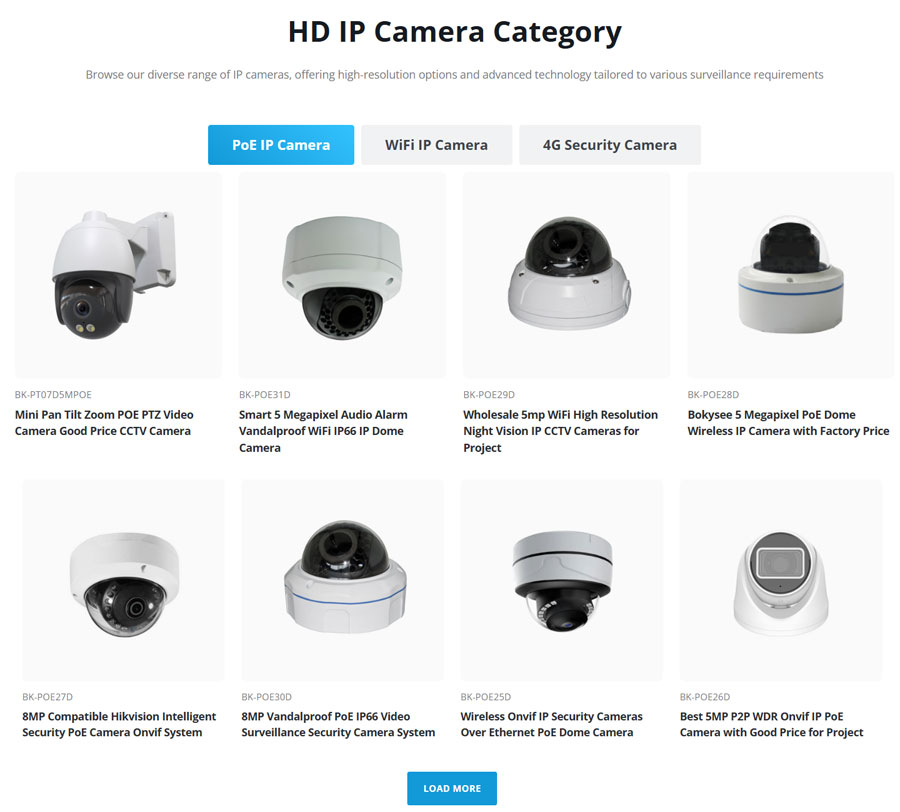
Características importantes de las cámaras IP
Las cámaras IP necesitan alta resolución para obtener videos nítidos y detallados. Deben tener entre 1,3 y 5 megapíxeles para obtener imágenes nítidas. Funciones como la detección de movimiento y la visualización remota las hacen más útiles. Las opciones inalámbricas permiten una ubicación flexible. La alimentación a través de Ethernet (PoE) combina alimentación y datos en un solo cable, lo que facilita la configuración.
Un cifrado robusto protege los videos de los hackers. Los usuarios pueden elegir entre almacenamiento en la nube o local. Las cámaras IP también deberían permitir la adición de más cámaras según sea necesario.
Ejemplo: Cámara IP Bokysee
El Cámara IP Bokysee Ofrece excelentes funciones y video nítido. Su resolución de 5 megapíxeles ofrece imágenes nítidas y detalladas. La detección de movimiento alerta a los usuarios sobre actividad inusual. El acceso remoto permite ver videos en vivo en teléfonos o computadoras.
Su diseño inalámbrico facilita la configuración y flexibiliza su ubicación. La tecnología PoE reduce la necesidad de cables adicionales, ahorrando tiempo. Admite almacenamiento local y en la nube para guardar videos de forma segura.
La cámara IP Bokysee tiene un precio inicial más elevado. Pero sus funciones avanzadas y su valor a largo plazo la hacen rentable. Es una excelente opción para las necesidades de seguridad modernas.
-
Las cámaras analógicas son baratas y fáciles de usar.
-
Funcionan bien para configuraciones de seguridad simples.
-
Las cámaras IP ofrecen imágenes más claras y tienen más funciones.
-
Son buenos para necesidades de seguridad modernas y mayores.
-
Elegir el adecuado depende de su presupuesto y espacio.
-
Piense en las características que necesita antes de comprar.
-
Marcas confiables como Bokysee ofrecen ambos tipos de cámaras.
-
Tienen opciones para diferentes necesidades de seguridad.
Ver también
Comparación de las cámaras de seguridad con IA y los sistemas tradicionales del futuro
Diferencias clave entre los sistemas de cámaras IP y los modelos tradicionales
Cómo seleccionar el fabricante de CCTV adecuado para su hogar
Las mejores marcas de cámaras IP para la seguridad del hogar en 2025

